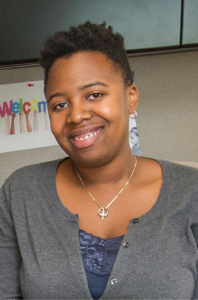 Trishelle Copeland-Johnson is a Ph.D. student in materials science and engineering (MSE). She is currently researching the explosions at the Fukushima Daiichi Power Plant in 2011, and she recently was awarded the American Society for Nondestructive Testing (ASNT) Fellowship.
Trishelle Copeland-Johnson is a Ph.D. student in materials science and engineering (MSE). She is currently researching the explosions at the Fukushima Daiichi Power Plant in 2011, and she recently was awarded the American Society for Nondestructive Testing (ASNT) Fellowship.
Tell us a little about yourself. Where are you from? What is your academic background? Why did you pursue engineering?
I am originally from Florida. I pursued my bachelor’s in chemical engineering from the University of South Florida in Tampa. Then, I pursued my master’s in chemical engineering from the University of Delaware. I am currently working on my Ph.D. in materials science & engineering at Iowa State University.
I pursued engineering because I wanted a career where I have the flexibility to contribute to addressing societal challenges from different perspectives. For instance, I can contribute to the direct development of new alternative energy technology as a research scientist. Or I can contribute to the commercialization of new technologies in industry.
Tell us a bit about what your studies and research involve.
I am involved with disaster-based research based on the explosions observed at the Fukushima Daiichi Power Plant in 2011. These explosions were attributed to the failure of a protective barrier layer that grows on the encasements, which we call claddings, used to seal radioactive fuel to form a nuclear fuel rod. The barrier layer shields the fuel rod from the extreme environment inside the reactor.
I am contributing to the development of a new class of materials to construct fuel rods with “accident tolerant” capabilities. The barrier layer grown on these materials can withstand emergency conditions in a nuclear reactor, similar to those observed at Fukushima. With this advantage, operators will have additional time to restore normal operations.
I characterize the composition and structure of the barrier layers grown on accident tolerant materials exposed to simulated conditions. Then, I analyze what properties of the barrier layers have changed and correlate how those properties relate to the material’s ability to withstand these conditions. This knowledge can then be used to tune the cladding materials to optimize their capabilities.
Ultimately, my work contributes to enhancing the knowledge base other scientists and engineers need to develop these accident tolerant cladding materials for constructing nuclear fuel claddings for operating nuclear power plants.
You recently received the American Society for Nondestructive Testing (ASNT) Fellowship Award. How will that impact your studies as a graduate student working in NDE?
I am a member of the Electromagnetic Materials Design and Characterization Group at ISU, which specializes in electromagnetic nondestructive evaluation (NDE) techniques, such as eddy current and dielectric spectroscopy.
My specialization is characterizing materials at the nano and microscale with techniques like microscopy and x-ray diffraction. The ASNT Fellowship provides me an opportunity to intersect my expertise with that of my research group to develop a novel NDE technique for measuring the growth of barrier layers grown on accident tolerant fuel claddings.
I will utilize information collected about the barrier layers at the micro/nano scale to identify the appropriate specifications that the technique needs to measure the barrier growth at the macro scale.
What faculty or other students have influenced your work at Iowa State? What collaborative projects have you previously or are currently working on?
My major professor Nicola Bowler, professor in materials science and engineering, has been very open-minded about her students fostering collaborations both on and off-campus to complete their dissertation research. For instance, my dissertation project sustains a partnership with Dr. Emily Smith, professor in the Department of Chemistry at Iowa State, and her graduate student Charles Nyamekye.
My project also has outside collaborators with the Department of Nuclear Science and Technology at Brookhaven National Laboratory, including Dr. Simerjeet Gill, group leader for the Materials for Energy Applications research group, and Dr. Lynne Ecker, department chair, as well as Dr. Raul Rebak at the General Electric Global Research Center.
What do you hope to pursue after completing your Ph.D.?
I hope to secure a postdoctoral appointment and eventually a scientist position at a national laboratory.
What advice would you give to women interested in pursuing STEM education and careers?
Find your champions, people who will advocate and support you when others doubt you because of their own implicit biases about the competence of women to pursue technical fields. There are too many individuals who are intimidated by ambition and impose their own insecurities to disenfranchise others, especially if the object of the ire is a woman of color.
The challenges against women of color are further confounded by being affiliated with a historically marginalized community, making it more critical for us to find our respective supportive communities. These are the people who know our capabilities and can remind us of them when we are going through difficult times.
